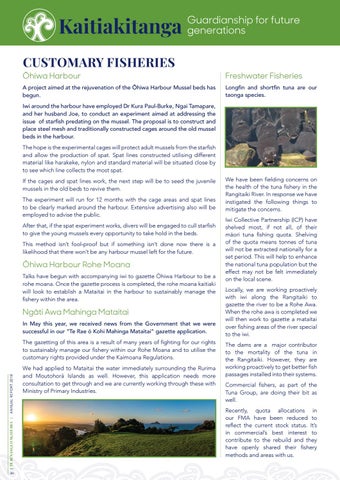TE RŪNANGA O NGĀTI AWA
Kaitiakitanga
Guardianship for future generations
CUSTOMARY FISHERIES
Ōhiwa Harbour
Freshwater Fisheries
A project aimed at the rejuvenation of the Ōhiwa Harbour Mussel beds has begun.
Longfin and shortfin tuna are our taonga species.
Iwi around the harbour have employed Dr Kura Paul-Burke, Ngai Tamapare, and her husband Joe, to conduct an experiment aimed at addressing the issue of starfish predating on the mussel. The proposal is to construct and place steel mesh and traditionally constructed cages around the old mussel beds in the harbour. The hope is the experimental cages will protect adult mussels from the starfish and allow the production of spat. Spat lines constructed utilising different material like harakeke, nylon and standard material will be situated close by to see which line collects the most spat. If the cages and spat lines work, the next step will be to seed the juvenile mussels in the old beds to revive them. The experiment will run for 12 months with the cage areas and spat lines to be clearly marked around the harbour. Extensive advertising also will be employed to advise the public. After that, if the spat experiment works, divers will be engaged to cull starfish to give the young mussels every opportunity to take hold in the beds. This method isn’t fool-proof but if something isn’t done now there is a likelihood that there won’t be any harbour mussel left for the future.
Ōhiwa Harbour Rohe Moana Talks have begun with accompanying iwi to gazette Ōhiwa Harbour to be a rohe moana. Once the gazette process is completed, the rohe moana kaitiaki will look to establish a Mataitai in the harbour to sustainably manage the fishery within the area.
Ngāti Awa Mahinga Mataitai In May this year, we received news from the Government that we were successful in our “Te Rae ō Kohi Mahinga Mataitai” gazette application.
| TE RŪNANGA O NGĀTI AWA | ANNUAL REPORT 2018
The gazetting of this area is a result of many years of fighting for our rights to sustainably manage our fishery within our Rohe Moana and to utilise the customary rights provided under the Kaimoana Regulations.
20
We had applied to Mataitai the water immediately surrounding the Rurima and Moutohorā Islands as well. However, this application needs more consultation to get through and we are currently working through these with Ministry of Primary Industries.
We have been fielding concerns on the health of the tuna fishery in the Rangitaiki River. In response we have instigated the following things to mitigate the concerns. Iwi Collective Partnership (ICP) have shelved most, if not all, of their māori tuna fishing quota. Shelving of the quota means tonnes of tuna will not be extracted nationally for a set period. This will help to enhance the national tuna population but the effect may not be felt immediately on the local scene. Locally, we are working proactively with iwi along the Rangitaiki to gazette the river to be a Rohe Awa. When the rohe awa is completed we will then work to gazette a mataitai over fishing areas of the river special to the iwi. The dams are a major contributor to the mortality of the tuna in the Rangitaiki. However, they are working proactively to get better fish passages installed into their systems. Commercial fishers, as part of the Tuna Group, are doing their bit as well. Recently, quota allocations in our FMA have been reduced to reflect the current stock status. It’s in commercial’s best interest to contribute to the rebuild and they have openly shared their fishery methods and areas with us.










